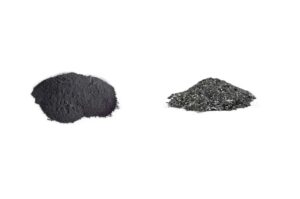Графит - это многоцелевое соединение, используемое в различных отраслях промышленности, таких как энергетика, смазочные материалы, электроника и др. Тем не менее, большинство людей не знают, что он выпускается в двух формах: натуральный графит и синтетический графит. В этом руководстве проводится сравнительный анализ обоих типов графита. Из него вы узнаете об их составе, применении и производстве.
Оглавление
Toggle
Обзор компании Nature Graphite
Природный графит - это органическое соединение, состоящее в основном из углерода. Когда богатый углеродом материал подвергается воздействию высокого давления и тепла внутри горной породы, образуется графит. Этот процесс занимает миллионы лет.
Шахтеры добывают природный графит из земли в различных формах. Однако три основные формы природного графита включают:
Аморфный
Аморфный графит имеет неупорядоченную структуру, обусловленную случайным расположением атомов углерода. Этот природный графит образуется в результате контактного метаморфизма между пластом антрацитового угля и агентом метаморфизма, таким как магма или тектоническое напряжение.
Хлопья
Природный чешуйчатый графит образуется, когда углерод подвергается воздействию высокого давления и температуры. Как правило, чешуйчатый графит добывается из месторождений метаморфических пород. Этот вид графита тонкий, плоский и имеет шестиугольный слой.
Кристаллический
Кристаллический графит известен своей правильной атомной структурой. Атомы углерода в этом графите расположены в виде гексагональной решетки.
Обзор синтетического графита
Синтетический графит - это искусственное соединение, полученное на заводе. Этот искусственный графит образуется при воздействии высоких температур в печи на углеродсодержащие материалы, такие как кокс, каменноугольная смола и т. д.
В отличие от природного графита, это соединение обладает точными свойствами. Поскольку он создан человеком, вы можете контролировать размер его зерен, чистоту и плотность.
Внешний вид синтетического графита более устойчив. Кроме того, его чешуйки мягче, чем у натурального графита.
Давайте сравним различные аспекты природного и синтетического графита.
Природный графит против синтетического графита: Сравнение различных факторов
Состав
Природный графит состоит из углерода и различных примесей. В основном он встречается в метаморфические породы. Графит образуется под воздействием метаморфизм богатого углеродом материала.
Содержание углерода в природном графите варьируется от 15% до 95%. Остальной состав может включать золу, железо, кремний, серу и т. д.
Синтетический графит, с другой стороны, содержит 99% углерода. Оставшиеся 1% содержат летучие вещества и золу.
Цвет
Оттенок натурального графита варьируется от темно-серого до черного. На нем также можно заметить металлический блеск.
Как правило, такая цветовая вариация обусловлена примесями, присутствующими в графите. Эта форма графита относительно более непрозрачна.
Цвет синтетического графита темнее благодаря его высокой чистоте. Поскольку это лабораторное соединение, оно отличается постоянным внешним видом. Кроме того, у него однородная и гладкая поверхность.
Производство
Как уже упоминалось выше, компании добывают природный графит в шахтах и карьерах. Это сырье подвергается различным видам обработки для улучшения его качества. В ходе этих процессов из графита удаляются примеси и сохраняется размер его частиц.
Инженеры-химики нагревают нефтяной кокс или каменноугольную смолу при температуре свыше 2500 градусов Цельсия. Это графитизация Процесс превращает углеродные материалы в графит.
Кроме того, он обеспечивает кристаллическую структуру синтетического графита благодаря выровненным атомам углерода.
Химические свойства
Природный графит остается стабильным при комнатной температуре. В стандартных условиях он химически инертен. Это означает, что графит не вступает в реакцию с кислотами, щелочами и другими растворителями. Однако органический графит может окисляться при температуре около 600 °C.
Синтетический графит обладает чрезвычайно высокой устойчивостью к воздействию химических веществ. Высокая плотность и низкая пористость делают его устойчивым к различным видам веществ.
Физические свойства/плотность
Плотность природного графита колеблется между 1,5 и 1,8 г/см³ в зависимости от его типа. Чешуйчатый и аморфный графит могут иметь незначительные различия в структуре и составе.
Синтетический графит немного плотнее природного. Его плотность колеблется в пределах от 1,6 до 1,9 г/см³. Кроме того, поскольку степень чистоты этого графита выше, он обладает лучшей тепло- и электропроводностью.
Цена
Цена на графит может варьироваться в зависимости от различных факторов. В зависимости от типа, сорта и рыночного спроса цена на природный графит может составлять от 500 до 2000 долларов США за тонну.
Синтетический графит стоит дорого. Его цена начинается от 3 000 долларов США за тонну. Стоимость некоторых премиальных сортов синтетического графита может достигать 20 000 долларов США за тонну.
Природный графит и синтетический графит: Применение
Натуральный графит
Огнеупоры
Природный графит широко используется для изготовления кирпичей и тиглей. Кроме того, его используют для изготовления форм в таких отраслях промышленности, как сталелитейная и стекольная. Ведь он обладает высокой термостойкостью.
Смазочные материалы
Природный графит имеет скользкую слоистую структуру. Поэтому компании используют его в смазочных материалах и консистентных смазках в качестве основного ингредиента.
Карандаши
Природный графит также используется для изготовления грифелей карандашей. Ведь это соединение оставляет след на бумаге.
Батареи
Производители аккумуляторов используют природный графит в качестве анодного материала в некоторых литий-ионных батареях. Он часто используется в недорогих батареях, которым не требуется большая мощность или производительность.
Литейный цех
Природный графит является основным ингредиентом в литейной и литейной промышленности. Компании используют его в качестве разделительного агента, чтобы предотвратить прилипание форм к металлу во время литья.
Тормозные накладки
Природный графит обладает выдающимися фрикционными свойствами. Поэтому автомобильные компании используют его для изготовления тормозных колодок и прокладок.
Области применения синтетического графита
Электроды
Синтетический графит способен выдерживать высокие температуры. Кроме того, он обладает высокой проводимостью. Поэтому производители электродов используют его для изготовления графитовые электроды для электродуговых печей.
Литий-ионные аккумуляторы
Синтетический графит используется в качестве анодного материала в литий-ионных батареях для электромобилей. Этот графит чище и имеет более однородную структуру, что улучшает характеристики батареи.
Топливные элементы
Синтетический графит также используется для производства биполярных пластин в топливных элементах с протонообменной мембраной (PEMFC).
Атомная промышленность
Этот искусственный синтетический графит обладает высокой термической стабильностью. Ядерщики используют его в качестве замедлителя и отражателя в ядерных реакторах.
Синтетический графит замедляет нейтроны и поддерживает деление ядер.
Заключение
Это всесторонний обзор того, как природный графит сопоставляется с синтетическим. Оба материала являются ценными соединениями, используемыми в различных отраслях промышленности.
Природный графит доступен по цене и подходит для тех случаев, когда не требуется высокая чистота графита. Напротив, синтетический графит стоит дорого. Однако он подходит для тех случаев, когда требуется самая чистая форма графита. В конце концов, он обеспечивает стабильную производительность.

